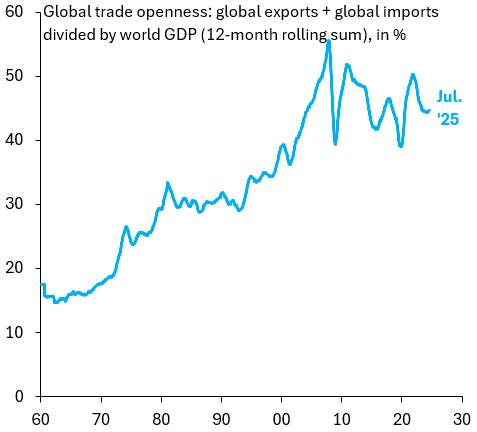The world is still at peak globalization
Everyone is talking about de-globalization, but the data tell a different story
There’s many reasons to think that globalization became excessive. First, substantial delivery delays during COVID illustrated how vulnerable global supply chains are to unexpected shocks. Second, Western dependence on Chinese rare earths underscores how important it is to keep some production lines at home because global geopolitics are unpredictable. Third, political polarization and the rise of populism in advanced countries is almost surely linked to the loss of manufacturing jobs to globalization.
So here’s the thing. Even with all the chatter about de-globalization and the tariff onslaught during this Trump administration and the last one, there’s really no sign that globalization has reversed in any meaningful way. That shouldn’t really come as a surprise. It takes many years to set up new production lines and - since this is costly - industry will resist doing this for as long as possible. The bottom line is that we’re still at peak globalization in terms of global trade. Whatever de-globalization is coming, it has yet to show itself in the data.
The chart above shows a widely-used measure of global trade openness, which is the sum of global exports plus global imports divided by world GDP. This ratio increased steadily until the global financial crisis, whereafter it went into a holding pattern with lots of ups and downs due to various shocks. While it’s true that globalization hasn’t advanced any further over the past decade, it hasn’t retreated either. We’re essentially in a holding pattern at peak globalization.
The fact that there’s been no retreat in globalization is consistent with all the work I’ve done on Chinese exports in recent posts. US tariffs have resulted in massive trade diversion of Chinese goods to the rest of the world as well as transshipment of goods to the US via third countries. In the end, however, China remains the biggest producer of goods and the US is the biggest consumer. Those two forces inevitably have to meet in global trade, just - these days - on a more circuitous route.


We may not be at “peak” globalisation yet. There is room for further improvement in both transport and in trade finance and documentation.
The arguments against globalisation are always built on nationalism and by definition they involve lower efficiency, higher costs and lower productivity.
Ricardo is right!
Although the graph for global openness seems to plateau, when I look at openness for China (ourworldindata) it has plummeted since 2006 @64% to 2023 @38%, while the USA has gone from 2011 @31% to 2023 @25%.
I'd suggest that something is going on when both the two largest economies have turned.